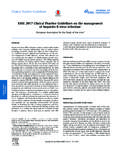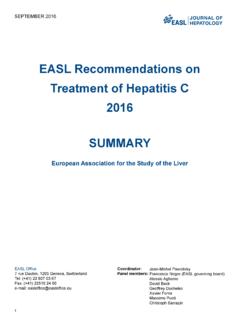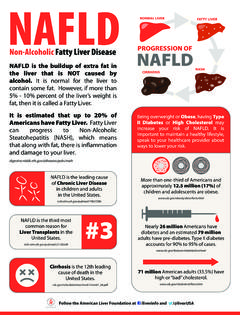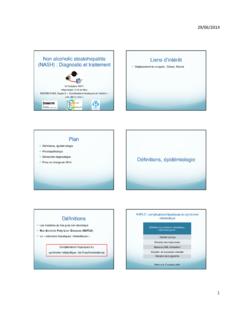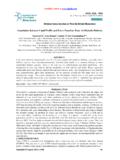Transcription of EASL–EASD–EASO Clinical Practice Guidelines …
1 EASL EASD easo Clinical Practice Guidelines for the managementof non-alcoholic fatty liver diseaseqEuropean Association for the Study of the Liver (EASL) , European Association for the Studyof Diabetes (EASD) and European Association for the Study of Obesity ( easo )IntroductionThe Clinical Practice Guidelines propose recommendations forthe diagnosis, treatment and follow-up of non-alcoholic fattyliver disease (NAFLD) patients and are the product of a joint effortby the European Association for the Study of the Liver (EASL),European Association for the Study of Diabetes (EASD) and Euro-pean Association for the Study of Obesity ( easo ). They update aposition statement based on the 2009 EASL Special Conference[1].The data have been retrieved by an extensive PubMed searchup to April 2015. The final statements are graded according tothe level of evidence and strength of recommendation, whichare adjustable to local regulations and/or team capacities(Table 1)[2].
2 In particular, screening for NAFLD in the popula-tion at risk should be in the context of the available resources,considering the burden for the national health care systemsand the currently limited effective treatments. The documentis intended both for practical use and for advancing the researchand knowledge of NAFLD in adults, with specific reference topaediatric NAFLD whenever necessary. The final purpose is toimprove patient care and awareness of the importance ofNAFLD, and to assist stakeholders in the decision-making pro-cess by providing evidence-based data, which also takes intoconsideration the burden of Clinical management for the health-care is characterised by excessive hepatic fat accumulation,associated with insulin resistance (IR), and defined by the pres-ence of steatosis in >5% of hepatocytes according to histologicalanalysis or by a proton density fat fraction (providing a roughestimation of the volume fraction of fatty material in the liver)> assessed by proton magnetic resonance spectroscopy (1H-MRS) or quantitative fat/water selective magnetic resonanceimaging (MRI).
3 NAFLD includes two pathologically distinct condi-tions with different prognoses: non-alcoholic fatty liver (NAFL)and non-alcoholic steatohepatitis (NASH); the latter covers awide spectrum of disease severity, including fibrosis, cirrhosisand hepatocellular carcinoma (HCC) (Table 2).The diagnosis of NAFLD requires the exclusion of both sec-ondary causes and of a daily alcohol consumptionP30 g formen andP20 g for women[1]. Alcohol consumption abovethese limits indicates alcoholic liver disease. The relationshipbetween alcohol and liver injury depends on several cofactors(type of alcoholic beverage, drinking patterns, duration ofexposure, individual/genetic susceptibility), rendering simplequantitative thresholds at least partly arbitrary. Specifically,patients consuming moderate amounts of alcohol may be stillpredisposed to NAFLD if they have metabolic risk factors.
4 Ofnote, the overall impact of metabolic risk factors on the occur-rence of steatosis appears to be higher than that of alcohol inthese patients[3]. The definitive diagnosis of NASH requires aliver of Hepatology2016vol. 64j1388 1402 Received 4 November 2015; accepted 4 November 2015qContributors: Coordinator EASL:Giulio Marchesini;Panel members:ChristopherP. Day, Jean-Fran ois Dufour, Ali Canbay, Valerio Nobili, Vlad Ratziu, Herbert Tilg;Coordinator EASD:Michael Roden;Panel members:Amalia Gastaldelli, HanneleYki-J rvinen, Fritz Schick;Coordinator easo :Roberto Vettor,Panel members:GemaFr hbeck, Lisbeth Mathus-Vliegen. Correspondence: EASL Office, 7 Rue Daubin, CH 1203 Geneva, : +41 22 807 0360; fax: +41 22 328 Guidelines were developed by the EASL, EASD and the easo , and arepublished simultaneously in theJournal of Hepatology, :ALT, alanine transaminase; BMI, body mass index; CAP, controlledattenuation parameter; CCR, chemokine receptor; CK-18, cytokeratin-18fragments; CKD, chronic kidney disease; CT, computed tomography; CVD,cardiovascular disease; EASD, European Association for the Study of Diabetes;EASL, European Association for the Study of the Liver; easo , European Associationfor the Study of Obesity; ELF, enhanced liver fibrosis; F, fibrosis stage; FIB-4,fibrosis 4 calculator; FLI, fatty liver index; HbA1c, glycosylated haemoglobin A1c;HCC, hepatocellular carcinoma; HDL, high-density lipoprotein.
5 HOMA-IR,homeostasis model assessment of insulin resistance; IFG, impaired fastingglucose; IR, Insulin resistance; LDL, low-density lipoprotein; MetS, metabolicsyndrome; MRI, magnetic resonance imaging; MRS, magnetic resonancespectroscopy; NAFL, non-alcoholic fatty liver; NAFLD, non-alcoholic fatty liverdisease; NFS, NAFLD fibrosis score; NAS, NAFLD Activity Score; NASH, non-alcoholic steatohepatitis; NPV, negative predictive value; OGTT, oral glucosetolerance test; PNHS, paediatric NAFLD histological score; PNPLA3, patatin-likephospholipase domain containing 3; PPAR, peroxisome proliferator-activatedreceptor; PPV, positive predictive value; PUFA, polyunsaturated fatty acids; RCT,randomized controlled trials; SAF, steatosis, activity and fibrosis; T2DM, type 2diabetes mellitus; TM6SF2, transmembrane 6 superfamily 2; UDCA, urso-deoxycholic acid; US, Practice GuidelinesRecommendations Patients with IR and/or metabolic risk factors ( obesity or metabolic syndrome [MetS]) should undergo diagnostic procedures for the diagnosis of NAFLD, which relies onthe demonstration of excessive liver fat (A1) Individuals with steatosis should be screened for secondary causes of NAFLD, including a careful assessment of alcohol intake.
6 The interaction between moderate amounts of alcohol and metabolic factors in fatty liver should always be considered (A1) Other chronic liver diseases that may coexist with NAFLD should be identified as this might result in more severe liver injury (B1)Prevalence and incidenceNAFLD is the most common liver disorder in Western countries,affecting 17 46% of adults, with differences according to thediagnostic method, age, sex and ethnicity[4]. It parallels theprevalence of MetS and its components, which also increasesthe risk of more advanced disease, both in adults and in is also present in 7% of normal-weight (lean) persons[5],more frequently in females, at a younger age and with normalliver enzymes. Their liver disease may nonetheless be progressive[6].NAFLD incidence has rarely been measured. It was 20-86/1000 person-years based on elevated liver enzymes and/or onultrasound (US), and 34/1000 per year by1H-MRS[7].
7 The need for NAFLD screening in the community has beenquestioned given the high direct and indirect costs of testing,the low predictive value of non-invasive tests, the risks of liverbiopsy and the lack of effective treatments[8]. However, the pro-gressive form of NAFLD ( NASH), particularly when associatedwith advanced fibrosis, should be identified in patients at risk(age >50 years, type 2 diabetes mellitus [T2DM] or MetS),because of its prognostic implications. Validated cost utility stud-ies on extensive screening programmes are eagerly awaited. Sim-ilarly, although familial clustering occurs, family screening is notgenerally advisable, with the exception of cases with definedinherited diseases ( lysosomal acid lipase deficiency).Recommendations All individuals with steatosis should be screened for features of MetS, independent of liver enzymes.
8 All individuals with persistently abnormal liver enzymes should be screened for NAFLD, because NAFLD is the main reason for unexpectedly elevated liver enzymes (A1) In subjects with obesity or MetS, screening for NAFLD by liver enzymes and/or ultrasound should be part of routine work-up. In high risk individuals (age >50 years, T2DM, MetS) case finding of advanced disease ( NASH with fibrosis) is advisable (A2) Table grade used for the EASL EASD easo Clinical PracticeGuidelines on NAFLD(adapted from the GRADE system[8]).Grading of evidence NotesSymbolHigh qualityFurther research is very unlikely to change our confidence in the estimate effectAModerate qualityFurther research is likely to have an important impact on our confidence in the estimate of effect and may change the estimate effectBLow or very low qualityFurther research is very likely to have an important impact on our confidence in the estimate of effect and may change the estimate effect.
9 Any estimate of effect is uncertainCGrading of recommendationsNotes SymbolStrong recommendation warrantedFactors influencing the strength of the recommendation included the quality of the evidence, presumed patient-important outcomes, and cost1 Weaker recommendationVariability in preferences and values, or more uncertainty: more likely a weak recommendation is warranted Recommendation is made with less certainty; higher cost or resource consumption2 Table spectrum of NAFLD and concurrent SubclassificationMost common concurrent diseasesNAFLD* NAFL AFLD-Alcoholic fatty liver disease Drug-induced fatty liver disease Hepatitis C virus-associated fatty liver (genotype 3) Others Haemochromatosis Autoimmune hepatitis Coeliac disease Wilson s disease A/hypo-betalipoproteinaemia lipoatrophy Hypopituitarism, hypothyroidism Starvation, parenteral nutrition Inborn errors of metabolism(Wolman disease [lysosomal acid lipase deficiency]) Pure steatosis Steatosis and mild lobular inflammationNASH Early NASH: no or mild (F0-F1) fibrosis Fibrotic NASH.
10 Significant ( F2) or advanced ( F3, bridging) fibrosis NASH-Cirrhosis (F4) Hepatocellular carcinoma^*Also called Primary NAFLD and associated with metabolic risk factors/compo-nents of Metabolic Syndrome:1. Waist circumferenceP94/P80 cm for Europid Arterial pressureP130/85 mmHg or treated for Fasting glucoseP100 mg/dl ( mmol/L) or treated for Serum triacylglycerols >150 mg/dl (> mmol/L).5. HDL cholesterol <40/50 mg/dl for men/women (< < mmol/L). Also called secondary NAFLD. Note that primary and secondary NAFLD maycoexist in individual patients. Also NAFLD and AFLD may coexist in subjects withmetabolic risk factors and drinking habits above safe limits.^Can occur in the absence of cirrhosis and histological evidence of NASH, but withmetabolic risk factors suggestive of burned-out of Hepatology2016vol.
